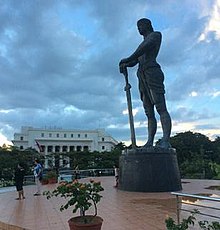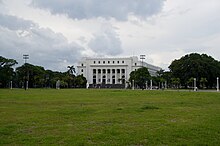
The Battle of Mactan was fought on a beach in Mactan Island between Spanish forces led by the Portuguese explorer Ferdinand Magellan along with local allies, and Lapulapu, the chieftain of the island, on the early morning hours of April 27, 1521. Magellan, a Portuguese-born commander serving the Spanish Empire who led an expedition that ultimately circumnavigated the world for the first time, commanded a small Spanish contingent in an effort to subdue Mactan led by Lapulapu under the Spanish crown. The sheer number of Lapulapu's forces, compounded with issues associated with the location and the armor, ultimately resulted in a disastrous defeat to the Europeans and the death of Magellan. Surviving members of Magellan's crew continued the expedition under the command of Juan Sebastian de Elcano, who completed the journey in September 1522.
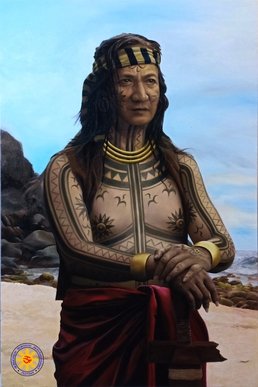
Lapulapu or Lapu-Lapu, whose name was first recorded as Çilapulapu, was a datu (chief) of Mactan, an island now part of the Philippines. Lapulapu is known for the 1521 Battle of Mactan, where he and his men defeated Spanish forces led by Portuguese explorer Ferdinand Magellan and his native allies Rajah Humabon and Datu Zula. Magellan's death in battle ended his voyage of circumnavigation and delayed the Spanish occupation of the islands by over forty years until the expedition of Miguel López de Legazpi in 1564.
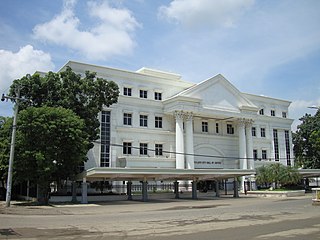
Lapu-Lapu City, officially the City of Lapu-Lapu, is a 1st class highly urbanized city in the Central Visayas region of the Philippines. According to the 2020 census, it has a population of 497,604.

Mactan is a densely populated island located a few kilometers east of Cebu Island in the Philippines. The island is part of Cebu province and it is divided into the city of Lapu-Lapu and the municipality of Cordova.
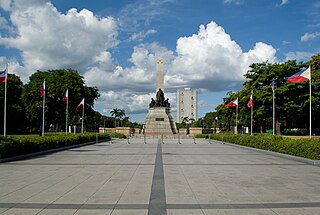
Rizal Park, also known as Luneta Park or simply Luneta, is a historic urban park located in Ermita, Manila. It is considered one of the largest urban parks in the Philippines, covering an area of 58 hectares. The site on where the park is situated was originally known as Bagumbayan during the Spanish colonial period. It is adjacent to the historic Walled City of Intramuros.
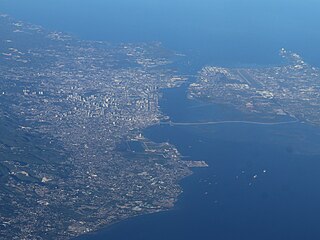
Metropolitan Cebu, or simply Metro Cebu,, is the main urban center of the province of Cebu in the Philippines. Metro Cebu is located along the central eastern portion of the island including the nearby island of Mactan. It accounts for 19.9 percent of the land area and 61.5 percent of the population of the entire province of Cebu.
This is an overview of current and former national capital cities in the Philippines, spanning from the Spanish colonial period to the current Fifth Philippine Republic. The current capital city, Manila, has been the country's capital throughout most of its history and regained the title through a presidential order in 1976, with Metro Manila serving as the National Capital Region (NCR) since 1978.

The Rizal Monument is a memorial in Rizal Park in Manila, Philippines built to commemorate the executed Filipino nationalist, José Rizal. The monument consists of a standing bronze sculpture of Rizal, with an obelisk, set on a stone base within which his remains are interred, holding his 2 famous novels "El Filibusterismo and Noli Me Tangere". A plaque on the pedestal's front reads: "To the memory of José Rizal, patriot and martyr, executed on Bagumbayan Field December 30 1896. This monument is dedicated by the people of the Philippine Islands."
Anastacio Tanchanco Caedo was a Filipino sculptor. His style of sculpture was classical realist in the tradition of his mentor, Guillermo Tolentino.

The National Historical Commission of the Philippines (NHCP) and its predecessor agencies in the Philippines and abroad installs historical markers to signify important and historic events, persons, structures, and institutions. The commemorative plaques are permanent signs installed by the NHCP in publicly visible locations on buildings, monuments, or in special locations. The NHCP also allows local municipalities and cities to install markers of figures and events of local significance, although these markers are barred from using the seal of the Republic of the Philippines.

Mangubat (Mang-gubat) ; is a Hispanic Filipino surname of Mactan Island origin which means " TO WAGE WAR " in Cebuano language.
In the Philippines, a freedom park is a centrally located public space where political gatherings, rallies and demonstrations may be held without the need of prior permission from government authorities. Similar to free speech zones in the United States, the existence of freedom parks are based on the premise that the government may regulate the time, place and manner of assemblies, without prejudice to the nature of expression being expressed in those assemblies.

The Rizal Monument in Calamba is a monument built to commemorate the sesquicentennial (150th) birth anniversary of Dr. José Rizal, the Philippines' unofficial national hero and the greatest son of Calamba. It is a 6.7 metres (22 ft) statue sculpted by Jonas Roces and is located at The Plaza, a 6.7-hectare (17-acre) park in front of the Calamba City Hall Complex along Bacnotan Road in the barangay of Real. President Benigno Aquino III led the unveiling of the monument on June 19, 2011. The monument was cited as the tallest Rizal monument in the world before former Laguna Governor Jeorge 'E.R.' Ejercito Estregan inaugurated a 26 feet bronze Rizal Monument sculpted by Toym Imao, son of National Artist for Sculpture Abdulmari Asia Imao in Santa Cruz, Laguna, for the 2014 Palarong Pambansa hosted by the province.

The Hoops Dome is an indoor arena in Lapu-Lapu, Cebu, Philippines. The venue occupies an area of 4,000 square metres. The Hoops Dome was completed in 2008 and was formally opened on July 2, 2011. It has hosted numerous PBA games since opening in 2011, most notably the Visayas leg of the 2017 PBA All-Star Week on April 30, 2017. It is also one of the home arenas of the Cebu Casino Ethyl Alcohol during the team's tenure in the Maharlika Pilipinas Basketball League from 2018 until 2020.

The Agrifina Circle, officially the Teodoro F. Valencia Circle, is a traffic circle within the eastern portion of Rizal Park in Manila, the Philippines. It has a diameter of 42 meters (138 ft).

The National Museum Complex in Manila refers to the main or central museums of the National Museum of the Philippines in Manila, most of which are within the grounds of the Rizal Park.
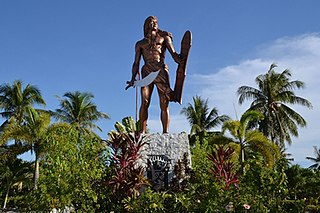
Mactan Shrine, also known as Liberty Shrine, is a memorial park on the island of Mactan in Lapu-Lapu City, Philippines. It hosts two monuments, namely the Magellan Monument, which is dedicated to Portuguese explorer Ferdinand Magellan and the Lapu Lapu Monument, a bronze statue which commemorates Lapu Lapu, a native leader who defeated Spanish soldiers led by Magellan in the 1521 Battle of Mactan.
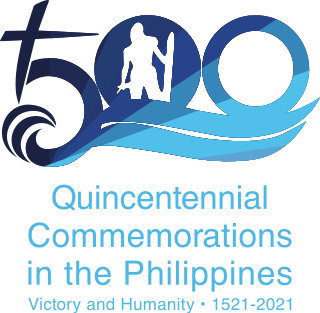
The 2021 Quincentennial Commemorations in the Philippines was a series of observances organized to mark the 500th anniversary of various events in the Philippines, notably the introduction of Christianity in the Philippines, the role of the country in the Magellan–Elcano circumnavigation, and the victory of Lapulapu in the Battle of Mactan.
The Lapulapu Memorial Shrine and Museum is a proposed museum and monument to Lapulapu to be built at Mactan Shrine in Lapu-Lapu City, Philippines.
